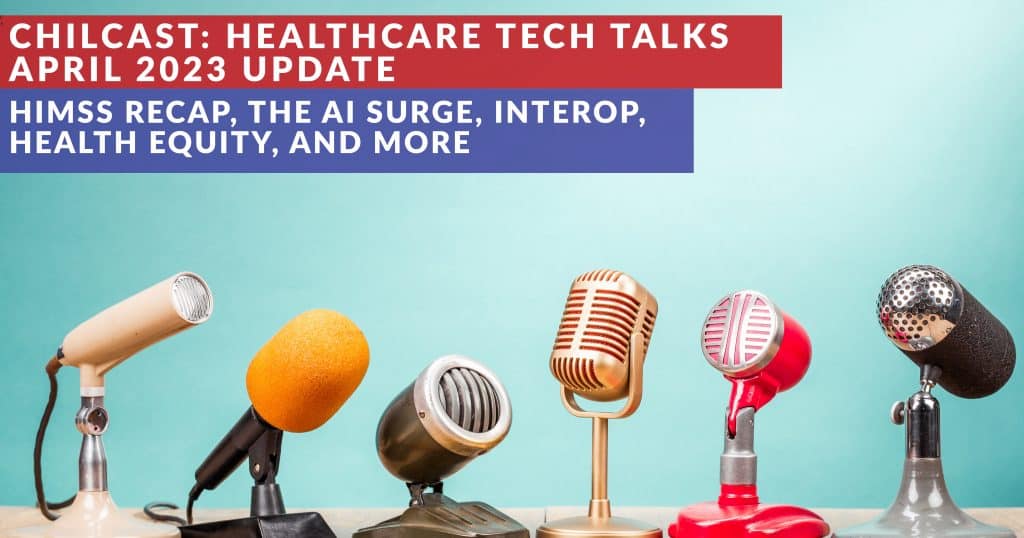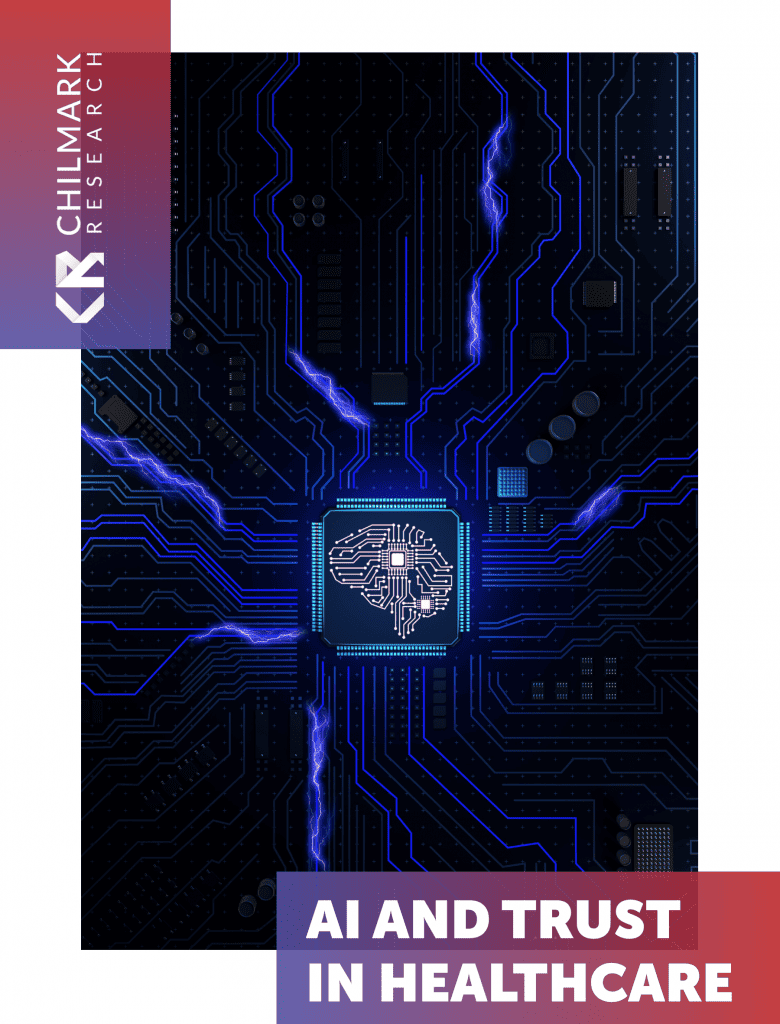Takeaways from my first HIMSS at the helm of Chilmark
Be sure to take a listen to our recent April Industry Update podcast episode that includes a post-HIMSS team discussion.
A Somber Start and an Outpouring of Community Support
“How’s the research coming along?” I asked, referring to a custom research project we were closing out soon.
“Oh, I’m actually working on my HIMSS post right now — hoping to have it ready for publication tomorrow,” he replied.
Not thinking much of it, I simply went about my day as usual. My father is a good writer and he’s done a dozen HIMSS posts at this point, so figured this would be more of the same — predictions, what we’re looking forward to, and what we’re listening for, much like the team post we published just before the event.
As many of you already know, it was not that kind of post. It was his farewell letter to the industry where he found his professional home and a very loving community of like-minded passionate, brilliant changemakers.
The timing and the topic of the piece cast a solemn shadow on a lot of my interactions this year, but it was truly heartwarming to see how many true friends we have in the community. I will admit, answering “How is he doing?” and “How are you holding up?” got old, but I knew the people asking weren’t just asking to be polite — it came from a place of legitimate care for our respective wellbeing as we navigate this difficult time.
The gift of these interactions is that I had the pleasure of being regaled with countless stories of how my father, both personally and through his work building up Chilmark Research, had touched so many lives in a surprising variety of ways. From dance parties, to airline delays, to bike rides, to ski trips, the stories people shared kept coming and I relished every single one.
In our business, we don’t always get to see the impact we have on people and organizations. We help people understand markets and make more informed decisions based on the insights our analysts develop through their research. We don’t design buildings, bake pastries, or write our own code (yet), so we typically only know we’ve created something valuable when someone takes the time to let us know directly.

So, a huge THANK YOU to everyone who made sure to let us know over the past few weeks. Seeing so much evidence of the value of our role in this community is exactly the fuel I needed to feed my personal fire as I find new ways to build upon the Chilmark legacy. I wish I could give thanks to each of you that made sure to say hi, but there were simply too many of you to fit into a post like this.
Another big thanks goes out to the whole Chilmark team, who have lifted me up when I’m doubting myself and are gracious enough to let me direct their various skills in the execution of our shared vision for the company. Plus, they’ve proven capable of balancing professionalism with having a good time at these conferences, one of those soft skills that my father taught me makes a good analyst. I can’t wait to see what we are able to accomplish together as build upon the existing foundation.
Immediate Changes
Management transitions are always hard, made that much more difficult when they haven’t been properly planned for due to sudden changes in circumstances. With that in mind, I will only be making some minor adjustments to our offerings in 2023 (view our 2023 Research and Services Summary).
Market Trends and Buyers’ Guides
I’ve been helping produce and sell our flagship Market Trends Reports for close to a decade now. The majority of our customers tend to value these reports for either the market trends that they discuss, or the buying insights and competitive intelligence provided by the in-depth vendor profiles.
In 2023, we will be introducing a new, reduced-fee Market Trends Report (MTR) that defines the category of offering and then covers the key considerations, market trends, regulatory changes, notable deals, forecasts, and buyer profiles shaping adoption of the technology under examination. We will be releasing our Hospital at Home and Real World Data / Evidence Market Trends reports this month.
MTRs will now be followed a month later with the release of a companion Buyers’ Guide. These Guides will provide emerging best practices on how to plan new implementations, recommendations for the different types of stakeholders, how ROI is usually determined with these offerings, curated case studies, and the in-depth vendor profiles we’re known for.
Review Boards
Given our future-forward focus on evolving, transformational technologies, we’ve always worked with other industry experts to vet our research content before going to press to make sure we don’t overlook any important nuances or details that warrant discussion. This was never a formalized process, but it has proven valuable over the years so we’re going to change that.
I am currently looking for people to *nominate* other experts they know in the industry that might be interested in helping us make sure we are doing our part to effectively steer healthcare innovation in the right direction. Other than us here at Chilmark, who would you trust to give you the best perspectives on the specific topics of the market that we cover? If you would like to recommend someone, please don’t hesitate to send us their name and contact info (if you have it).
AI and Cybersecurity
We have been covering AI as its own topic area for a few years now. We will continue to provide specific coverage of new developments that affect the AI/ML, NLP, etc. realm, particularly in the area of ethics and responsible development. However, with AI now working its way into any offering that handles data, we will also start including a section in every report that looks specifically at the AI use cases in that category of solutions and how different organizations are approaching the implementation of these new tools.
Similarly, we will be looking at including a cybersecurity section to every research project going forward. I have been helping to feed our newsletter and social channels with quality content from external sources for years, and in the process of scanning headlines every day, I have come to appreciate the sheer volume of attacks / breaches that plague this industry. While cyber isn’t exactly transformational to care in its own right, mitigating the issues around data privacy, ability to operate, and data accessibility all factor into the comprehensive care experience for patients and providers.
We will therefore look at the unique attack vectors of any category of solution, how vendors are (or are not) protecting their data assets from malicious actors, and organizational considerations for keeping staff compliant with best practices. Be forewarned: simply relying on cloud infrastructure vendors for security isn’t going to cut it as we look to the future. This came straight from the horse’s mouth – I spoke with someone from the CISO’s office for one of the top cloud infrastructure providers and they warned that not having an effective cyber plan for your organization beyond your cloud hosting provider is going to be a growing problem for unprepared entities going forward as the 405(d) Program grows.
ChilCast: The Chilmark Podcast

Now that our team is fully remote, we are going to put our video production work on hold and focus on our podcast! We just recently started a monthly series wherein the team discusses news highlights from the last month, updates and early findings from current projects, and opportunities to engage with us for research or podcasting. Be sure to check out our latest episode looking back at April.
Be sure to subscribe via your favorite podcasting app, which you can find linked here.
Act Soon for Custom Work
We left HIMSS this year with more inquiries for custom research than we have since 2019. The event overall left the impression that business is finally close to normal again for the first time since 2020 – even if macroeconomic tailwinds remain worrisome. This means that if you think your organization will have any bespoke research needs in the year ahead, please be sure to reach out as soon as possible so we can work your project into the queue.
If all goes as planned, there will be some more announcements later in the year about new offerings, but for now this covers the major updates. Now let’s talk HIMSS.
HIMSS23: The Market Enters a New Phase

In typical HIMSS fashion, the theme this year was the appropriately vague but aspirational sounding “Health that Connects + Tech that Cares.” Obviously, that was superseded by the bigger tech conversation happening across society right now: how many use cases can we come up with for generative AI. Since Jody digs into that more in his event recap – as have plenty of others across industry outlets – I won’t belabor the point here.
However, I will call attention to the fact that we are making our “AI and Trust in Healthcare” report from last fall FREE to the public in response to the clear market need for more understanding of ethical and responsible development practices. This is the only way to create much required trust with users and the public that will lead to new tools for changing the care delivery experience.

This completes my first decade of attending HIMSS events, and while it could just be the return to normal size after 3 years, it’s starting to feel like we’re entering the next phase of the industry’s evolution. HITECH and Meaningful Use spurred the first wave of innovation in healthcare IT, resulting in the artificially rapid growth of data assets in a profession that was historically pretty slow to adopt digital technologies outside of academic pursuits. This first phase was driven by that $10B federal sponsorship of rapid EHR implementation, with HIEs following quickly thereafter as the first stab at actual interoperability.
After the MU program ended, we saw a period of relative chaos in a market lacking an obvious focal point for everyone’s attention — with the possible exception of the overly broad ‘analytics’ category. This created new opportunities by allowing market forces to return, incentivizing an explosion in best-of-breed solutions to meet needs created by unintended consequences of the HITECH act, new innovations in consumer technologies, or stemming from the many use cases of all these novel data assets that have been created.
This period also saw accelerated market consolidation as many companies were acquired / divested or simply failed, leading to plenty of lessons on what works for this market and how health IT is often different than other enterprise technology industries.
I would argue we are still very much in this reshuffling period, but what I took away from HIMSS this year — in combination with some other macro factors at play — is that we are on the cusp of the next federally-driven era of tech innovation in healthcare. Whether that is something as specifically focused as the HITECH Act, or a set of more general new initiatives like we’ve been seeing recently, HIMSS23 made it clear [to me] that the change we all want to see needs federal intervention to guide the market forces at play. Unscrupulous private money is mucking things up too much looking for quick returns (Cerebral or rural hospitals anyone?), and while I am loathe to admit it, the market needs a guiding hand to focus those incentives on the areas that will make true impact for society.
At the time of writing this, the COVID Public Health Emergency has just officially come to an end. Paired with the debt ceiling debates, this could have significant impacts on CMS beneficiaries given proposed budget cuts and Medicaid redeterminations taking effect over the coming months. Following all the disparities in care exposed by the pandemic, this is going to exacerbate conditions, bringing the country to a crisis point around costs of care and equity of access. Julie Rovner and her team at What the Health? have covered the potential fallout from this extensively over the last few months if you want to go deeper on the Medicaid redeterminations and impact of the PHE coming to an end (their The ‘Unwinding’ of Medicaid episode from the week before HIMSS was entirely focused on this topic).
From a public health perspective, what we are facing as a country right now should make everyone uneasy. Struggling health delivery organizations, a shrinking and burnt out critical workforce, massive inequities of care access and quality, poor patient data rights oversight, perpetually rising costs of care, rampant inflationary forces, a possible recession on the horizon, and ongoing political strife domestically are all factors contributing to the generally unstable market conditions we see today. Add to that our urgent need for new HIPAA legislation, guidance on AI/ML, and faster CMS reimbursement for effective new care models, something has to be done at the federal level soon to head off a catastrophic market implosion.
So what would the next iteration of federally supported health IT innovation look like? Only time will tell of course, but if I had to make an educated guess, we’re going to see some significant carrot / stick incentives introduced to start fixing the equity and accessibility issues (ACO REACH is a start). Driving new new models of care that can level the playing field and improve accessibility such as hospital-at-home, retail health, or virtual care, will be part of the payer mandate going forward, with CMS needing to take the lead to see real change in the acceptability of these sites for care. Whereas the HITECH Act was focused on investing in nationwide adoption of the foundational systems of record known as electronic health records (EHRs), expect the next wave to be focused on specific categories of systems of engagement and insight that are identified as having the most evidence-based impact.
Where do we go from here?
Investing in Care Coordination
When I think back on my meetings in Chicago, something one of the executives at PointClickCare brought up really stuck with me: many segments of the entire healthcare ecosystem were left out of the innovation wave sparked by HITECH. One of these is the LTPAC space they specifically address, which is disproportionately paid for by CMS, ie taxpayers. A recent NEJM Catalyst survey showed that globally, the two most significant barriers to patient care transitions are care delivery fragmentation and poor communication between providers. Given that 70% of Americans over 65 will have need for these services, this is creating massive waste and inefficiencies in our health system that really don’t need to exist.
I also met with Greg Miller, who has apparently been friends with my father since his time with Medicity in the early HIE days, when the industry didn’t really know how to define that type of technology. The two of them bonded over the work they did together to identify the core competencies of an HIE and help the rest of the community frame their perspectives on what could be expected. Greg is now at Lumeon embarking on a similar journey to create a new ‘care orchestration’ concept for enterprise health IT. Check out the recent research brief we developed together to see how this kind of automation is currently going through.
Decentralization
There are two notable vectors by which the global trend of tech-enabled decentralization is entering the healthcare sector: omnichannel care and clinical research. This is not to be confused with the decentralization that you see in the blockchain space, but it is in part driven by similar social changes enabled by digital technologies.
A friend from my Startup Health days, Sandeep Pulim, VP of Clinical Strategy and Partnerships at Biofourmis, gave me a walkthrough of their impressively comprehensive home care platform (check out my interview with Sheeza Hussain from HLTH21) as part of our upcoming research on the Hospital-at-Home space. This solution provides its own network of mobile clinicians, remote patient monitoring devices, and approved community resources that can help address social needs (SDoH). What this solution doesn’t do? Take the patient out of the comfort of their own home to get the care they need. This is one example of how decentralization is being applied to sites of care and expanding the omnichannel care concept.
I also had the pleasure of meeting with Glenn Keet, another HIE veteran as one of the Co-Founders of Axolotl. He introduced me to how Invitae, through its acquisition of Ciitizen, is enabling better research on rare diseases by decentralizing the clinical research process through real world data (RWD). Of particular note is that they were able to help a company (Praxis) file an IND application with the FDA by utilizing natural history data they collected – with patient awareness and consent.
That last piece is really the sticking point for me, as RWD is typically mined and sold without any patient awareness that their de-identified record is now available to anyone that can afford it. By flipping the script, Invitae is putting the power back in the patient hands, and even revenue shares some of the trial money back to the patient as well as their advocacy group partner for the rare condition. I wish more companies were willing to give back to the patients directly in such a way (meaningful data rights and ownership regulations are still lacking, despite people talking about it for years now).
Ethics, Responsibility, and Social Awareness
Social responsibility in solution/company development is the one that seems most likely to require federal intervention to standardize and normalize how we monitor what matters within healthcare. There are lobbying groups and professional organizations that develop tools and frameworks to effectively think about how these social issues factor into the development of new data solutions. However, without some degree of oversight and regulation, these topics are rife with opportunity for exploitation or green-washing.
I’ll admit that I was completely floored by the DataRobot demo and how they are creating a truly responsible AI development framework. I’ve mentioned this demo in countless conversations since HIMSS because it stuck with me so potently. What I found so fascinating was the ability to test models against data to: see which model performs best for the desired predictive outcome; determine if there is any bias detectable in age, gender, or race; and generate a regulatory audit document that explains the model. After listening to Jody talk about responsible AI development for a couple years now, it was really cool to see everything he was talking about in action with a live demo. (Check out the “In AI we Trust?” episode with Dr. Haniyeh Mahmoudian, DataRobot’s Global AI Ethicist).
Closing Thoughts
This was a mere sample of the many meetings I had at HIMSS23 this year, meant to highlight some of the key topics that are of most interest to me personally, and how these fit into the bigger trends that I see shaping the industry today. I spent a ton of time with the interoperability folks, meeting with Orion Health, CommonWell, Zus, Moxe, Kyruus, Gorilla Health and Rhapsody. What I noticed from these conversations is that the whole interop conversation seems more practical than I recall from years back when it was very aspirational. A lot of people were excited about the QHINS program, and what that could mean for records accessibility if successful. The inherent lack of interoperability has been the bane of seeing that all these data assets achieve their full potential, so seeing substantive progress here that goes beyond FHIR is encouraging.

As always, HIMSS was a lot of fun, simply because I got to spend so much time with the Chilmark team and my other friends within the community in person. Roaming Chicago with the crew was a charming experience, and finishing up our team activities with the sold out party at the House of Blues on Wednesday evening was definitely a highlight of the evening activities. This year I was reminded just how important the work we do here is, and that we have the support network to make sure we’re able to keep providing you with what you’ve come to expect.
I’m more excited than ever to make good on those expectations, so please stay tuned, buckle up, and enjoy the ride.




0 Comments